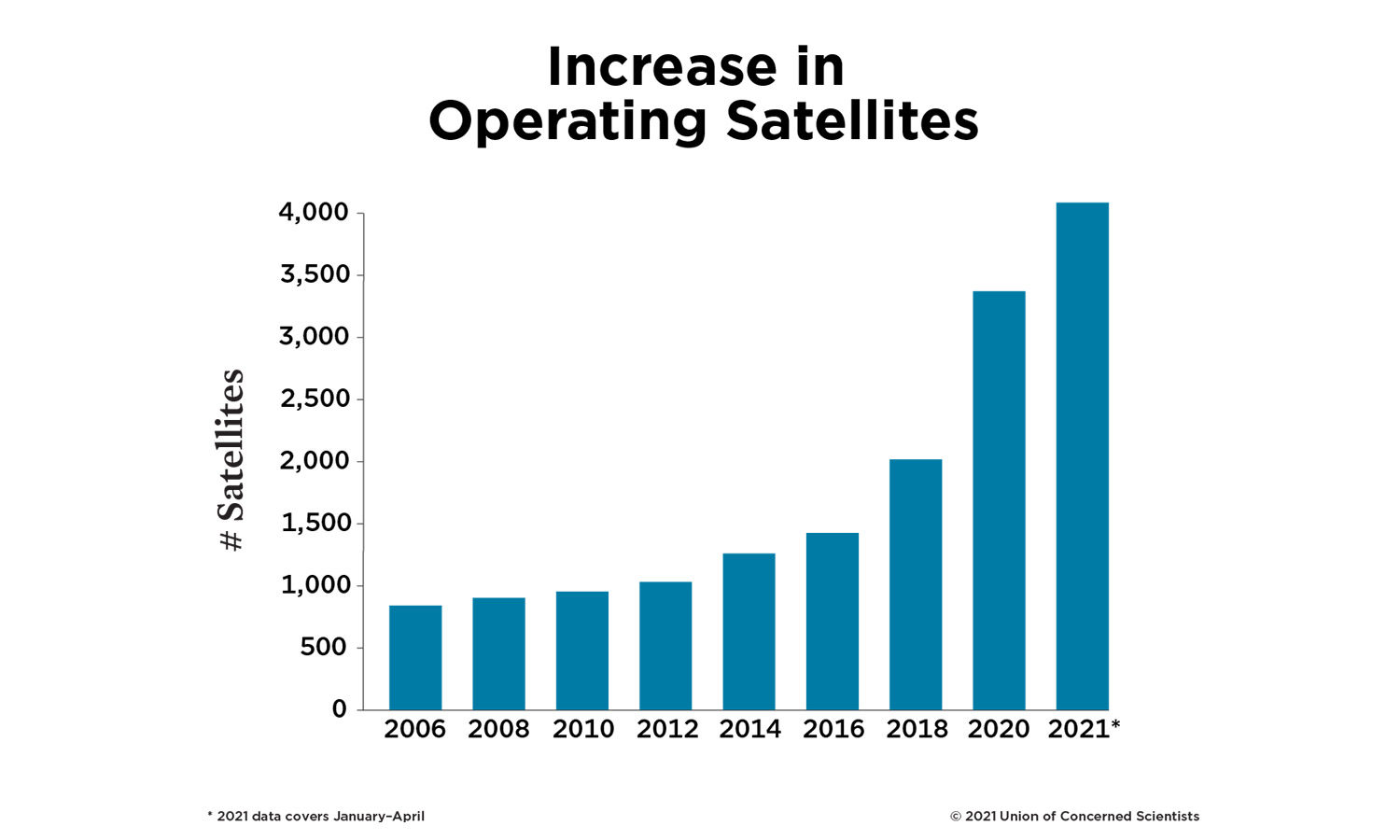In the four months between January 1 and May 1, 2021, a startling 836 satellites were launched into orbit, pushing the total number of active satellites to more than 4,000 for the first time. That is on top of a single-year increase of 925 operating satellites in 2020 and 304 in 2019, an accelerating growth pattern that has been building since 2014. Given the plans of companies like Starlink, dramatic increases in numbers of satellites seem destined to continue, although the rate of change will almost certainly decline.
UCS has tracked the number of operating satellites circulating the globe since 2005, and regularly releases our UCS Satellite Database, free to the public, with a good deal of supplemental data. Our latest release of the database finds that, as of May 1, the total number operational satellites in Earth orbit is 4,084, adding the 836 new satellites launched and subtracting roughly 120 that ceased operations since our last report.

At some point, this acceleration will slow down, as the current exponential growth pattern is not sustainable. The acceleration reflects the deployment of major constellations of satellites that will be maintained but not massively expanded. However, even with a slowdown in the rate of increase, total numbers are certain to continue to expand, and that could have implications for the planet.
In particular, it increases the likelihood of collisions between objects in space, which can create more space debris and increase the chance of additional collisions. Just last year, a collision nearly happened between a dead Russian satellite and an old Chinese rocket body. That followed the 2009 collision between an operating US satellite and a decommissioned Russian satellite, one that led to at least 823 large pieces of debris at the time. If a chain reaction does happen in space, it could significantly affect society, as more and more elements of our everyday lives rely on space-based communications and data.
Starlink update
As of May 1, there were nearly 1,500 Starlink satellites in orbit, with 550 having been added during the first four months of 2021. In April the Federal Communications Commission approved a change in Starlink’s license that allowed it to operate more satellites at a lower orbit than had previously been permitted. The constellation will now operate at an altitude of 540 and 570 kilometers, and not higher than 580 kilometers. The limit of 580 was a condition requested by Amazon to avoid close approaches to its Project Kuiper satellites, and accepted by SpaceX.
A number of astronomical associations, concerned about the impact that Starlink has had on astronomical observations, requested that the FCC perform an environmental assessment of the Starlink constellation. This request was denied, but the FCC did encourage SpaceX to continue to work closely with astronomers to mitigate the brightness of its satellites.
Space stations and orbital opportunities
One new trend does not impact the UCS count of operating satellites: we do not track objects that only pass through space temporarily, so billionaires or others who might fly up briefly and then return to ground will not increase our satellite numbers. However, it is worth noting some news related to space stations, which are counted.
China’s space station
On April 29 the first and core component of China’s Space Station — Tiangong (Heavenly Palace) — was placed into orbit. Named Tianhe (Harmony of Heavens), this first module will serve as the control center and living quarters of the station. Two more modules that will function as laboratories will be launched in 2022. The space station will be able to host three crew members at a time. China has declared that Tiangong will be open to host non-Chinese crews and science projects, and nine other nations have already signed on to fly experiments aboard Tiangong, which has an expected life of 15 years.
International space station and space tourism
The International Space Station (ISS) is scheduled to be decommissioned in 2024, with the possibility of an extension to 2028. In the meantime, plans for orbital tourism are moving ahead. Russia’s Roskosmos State Corporation has been reviewing a business plan for the addition of a high-comfort module to the ISS, a luxury orbital suite parked at the ISS offering private cabins with big windows, personal hygiene facilities, exercise equipment and even Wi-Fi. Space tourists will have an opportunity for space walks accompanied by a professional cosmonaut.
The trip, one to two weeks in duration, will cost $40 million per person. If the tourist wishes to extend the stay to a full month and include the space walk, it would cost an additional $20 million. How far these plans will progress is dependent on significant factors.
Those trips, however, would not be counted in our satellite database.
Finally, kudos to my colleague, Teri Grimwood, UCS Satellite Database researcher, for tracking down 28 pieces of information for each of these 4084 satellites. If you’d like email notification when the updates are made, please sign up here.

